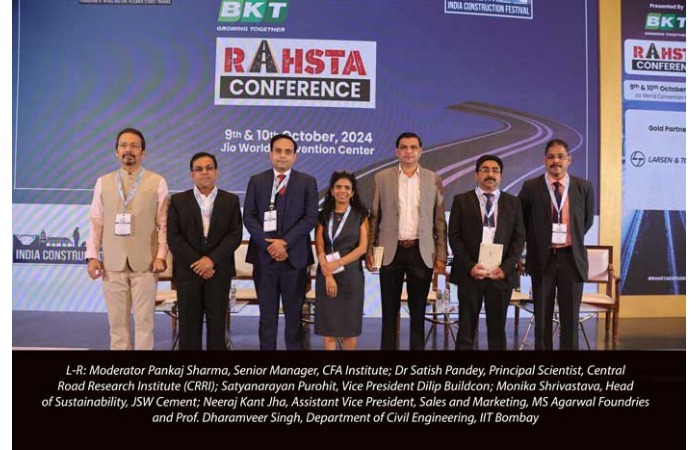
India’s road network consumes 1.2 billion tonne of natural aggregates annually
The road construction industry, as the demand for eco-friendly infrastructure grows, is adopting innovative methods to reduce emissions and embodied carbon in materials. These advancements not only address the global push towards sustainable development, but also set a path for a more resource-efficient future in infrastructure.
Embodied and operational carbon in cement sector
“While operational carbon – emissions during usage – get much attention, embodied carbon, which accounts for emissions during construction represents a significant portion, especially in highways where 50-60 per cent of carbon is embodied,” said Monika Shrivastava, Head of Sustainability, JSW Cement, while highlighting the importance of addressing both embodied and operational carbon footprints in road and infrastructure projects. She noted that using ground granulated blast furnace slag (GGBS) as an eco-friendly alternative to ordinary Portland cement (OPC) reduces carbon emissions from 740 kg per tonne (OPC) to 80 kg per tonne, significantly lowering the environmental impact. Since cement manufacturing emits significant amounts of CO2, around 20 per cent of the company’s energy is sourced from renewables, including solar power. The company aims to increase this from 20 to 60 per cent by 2030, aligned with the company's broader sustainability goals.
Use of eco-friendly materials
“In many of our road projects, we’ve implemented pavement quality concrete (PQC) and residual pavement methods with cement content limited to 450 kg per cubic metre,” said Satyanarayan Purohit, Vice President, Dilip Buildcon, emphasising the company's commitment to sustainable construction practices. As a case in point, he highlighted the use of ground granulated blast furnace slag (GGBS) in construction of the Zuari Bridge in Goa, where approximately 90,000 metric tonne of GGBS were utilised, and reducing carbon emissions by around 40,000 tonne. Purohit mentioning challenges in using recycled plastic in road construction noted that sourcing remains an issue. Looking ahead, he advocated further research into bio-bitumen, which could impact India’s road construction economy saying, “If bio-bitumen can be harnessed, it could revolutionise the industry.”
Waste to wealth
“In infrastructure development, the focus must be on the three R's: reduce, reuse, and recycle,” said Dr Satish Pandey, Principal Scientist, Central Road Research Institute (CRRI). “India has the second-largest road network globally, which consumes approximately 1.2 billion tonne of natural aggregates annually for construction and maintenance,” said Dr Pandey. To tackle this growing shortage of natural aggregates, CRRI has developed steel slag road technology, which repurposes waste steel slag as a substitute for natural aggregates. India produces around 20 million tonne of steel slag annually, a figure that is expected to triple by 2030.
Steel and CO2 footprint
“Steel is the backbone of infrastructure and its production has both challenges and opportunities, especially as global standards push for reduced carbon emissions,” said Neeraj Kant Jha, Assistant Vice President – Sales and Marketing, MS Agarwal, emphasising the critical role of the steel industry in infrastructure development and sustainable highway construction. “Our commitment to delivering greener steel aligns with the increasing demand from customers for environmentally friendly products,” said Jha about the sector’s adoption of electric arc furnaces (EAFs). As The Indian steel sector is set to undergo a major transformation, with the Ministry of Steel targeting net-zero emissions by 2070, requiring an investment of around $230 to $240 billion, Jha stressed the need for innovative energy sources, such as hydrogen, to replace traditional coal-based processes.
Materials, machinery and skilled workforce
“Machinery alone cannot construct roads; it is the trained workforce that ensures quality and sustainability. If any link in this chain is weak—be it subpar manpower or machinery—the goal of achieving sustainable infrastructure will falter,” cautioned Prof Dharamveer Singh from the Department of Civil Engineering at IIT Bombay. He pointed out that despite having access to world-class machinery and materials he had witnessed numerous road failures within just two years of construction due to inadequate training and quality control. He also suggested adoption of innovative technologies to improve road longevity and reduce reliance on natural aggregates.


 +91-22-24193000
+91-22-24193000 Subscriber@ASAPPinfoGlobal.com
Subscriber@ASAPPinfoGlobal.com